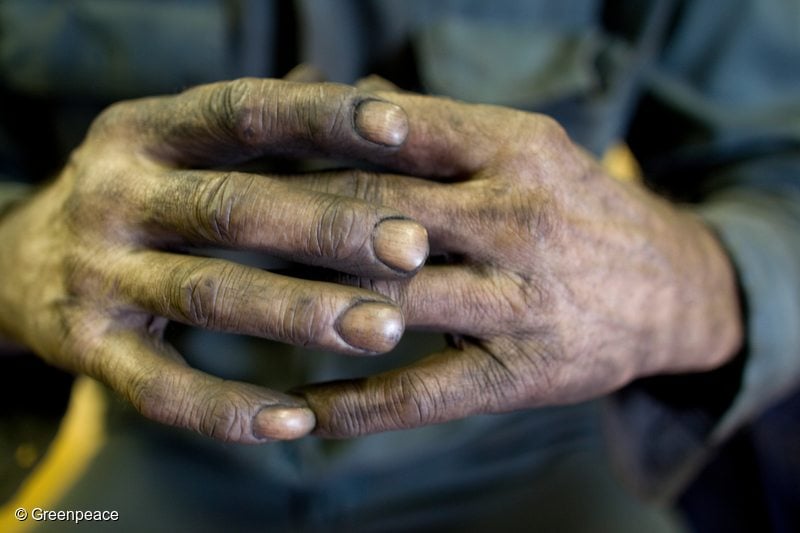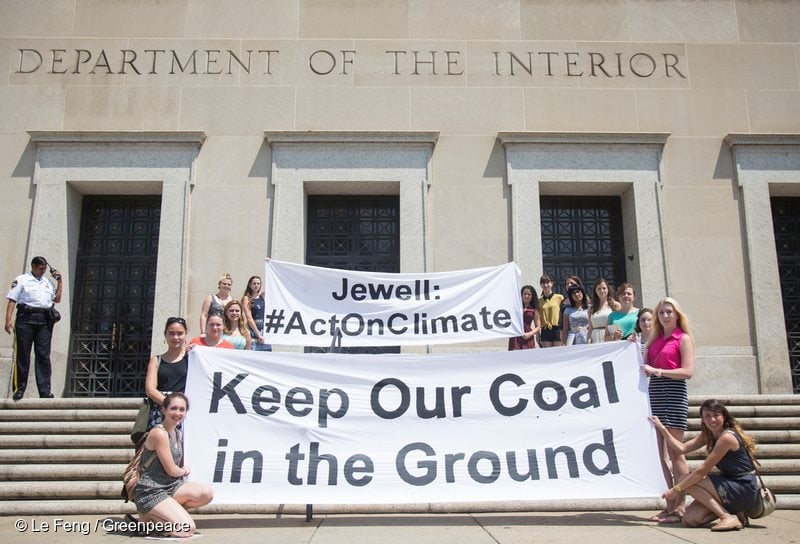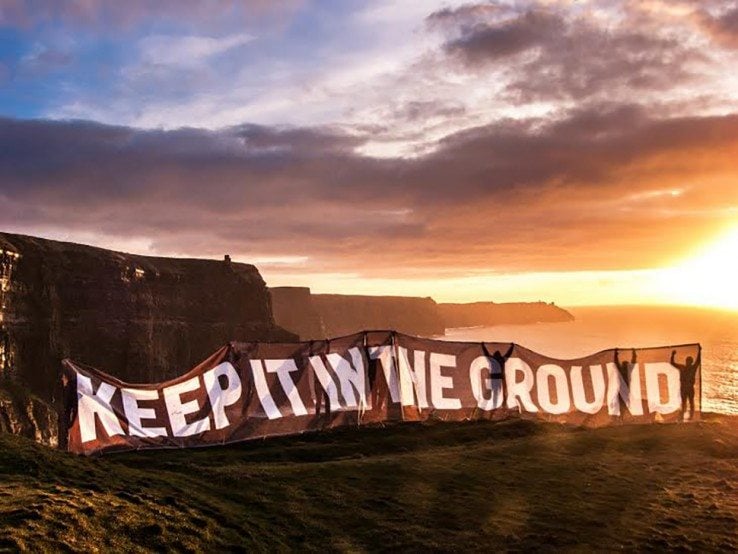How the keep it in the ground movement scored a big win over the ailing U.S. coal industry.
On January 15, 2016, the Obama administration announced a major step forward in the fight to keep fossil fuels in the ground. After years of people-powered organizing and activism against coal mining on public lands, the Interior Department has halted coal lease sales on publicly-owned land, effectively keeping billions of tons of coal in the ground.
Here’s Why It Matters
Even as global reliance on coal decreases, it’s still the single largest contributor to global warming. In fact, one-third of all global carbon emissions come from burning coal. Coal mining and coal-burning power plants are also linked to devastating local pollution and public health impacts.
In the United States, the biggest contributor to this problem has long been the federal coal leasing program, which falls under the jurisdiction of the Interior Department. During the Obama administration alone, the Interior Department leased 2.2 billion tons of coal, unlocking more than 3.9 billion metric tons of carbon pollution — more than the annual emissions of the entire European Union.
And all of that comes from public lands — land that belongs to you and me.
Prior to this announcement, the federal coal leasing program hadn’t been reviewed in more than 30 years. It’s time for an update, and, thanks to your action, we’re finally getting one.
Here’s How You Made It Happen
President Obama and Interior Secretary Sally Jewell did not come to this decision out of nowhere. It took years of action from people like you to expose devastating environmental and economic effects of the federal coal leasing program — and even more to convince our government to do something about it.
More than 100,000 of you signed petitions, 90,000 submitted comments to the Interior Department during opening listening sessions, and millions helped to spread the word on social media. We had some fun, too, like when more than 2 million people watched as this marmot in Glacier National Park — whose habitats are threatened by climate change — got up close and personal with our camera.
Furry creatures aside, these were some of the pivotal steps along the way.
“The Best Interests of the Nation”
The Interior Department is charged with managing America’s natural resources, including coal, in “the best interests of the nation.” Somewhere along the line, it became necessary to remind the Obama administration where those interests lie.
As it turns out, the federal coal leasing program was effectively subsidizing coal companies and fueling climate change at the expense of American taxpayers.
A June 2013 report from the Interior Department’s own Inspector General found significant flaws in the way it was calculating the value of coal, leading it to basically give away publicly owned coal to companies like Peabody, Cloud Peak Energy, and the now-bankrupt Arch Coal. Another report found that taxpayers lost nearly $30 billion because of issues with the way the market value of coal had been determined.

A coal miner after his underground mining shift in West Virginia.
With mounting evidence that the federal coal leasing program was in desperate need of an overhaul, climate activists came together with communities and organizations concerned about the impacts of coal mining and exports to call for an immediate moratorium of coal leasing on public lands.
Secretary Jewell, Meet the Climate Movement
On her first day as Secretary of the Interior in 2013, the federal entity that oversees our public lands and the fossil fuel reserves they house, Sally Jewell heard loud and clear that the federal coal program was broken.
Greenpeace, together with 20 other organizations, sent the incoming Secretary a letter calling for “an immediate moratorium on new coal leasing in the Powder River Basin and a comprehensive review of the federal coal leasing program.” Coal mining in the Powder River Basin alone is responsible for 10 percent of all U.S. carbon pollution.

Greenpeace activists hold a banner at the Department of Interior urging Secretary Sally Jewell to stop leasing public land for coal mining in the Powder River Basin in July 2013.
Soon after, youth climate activists visited the Interior Department headquarters to call out the contradictions between the federal coal leasing program and President Obama’s recently released Climate Action Plan. Secretary Jewell also faced tough questions about the federal coal program from activists in the Pacific Northwest and around the country.
But we didn’t stop there. For the next several years, activists, students, and community leaders showed up around the country to ask her to end coal leasing on federal lands in places like Montana, Wyoming, California, Florida, and more.
To Keep It in the Ground, Take to the Sky
Despite all that, the Interior Department and Secretary Jewell failed to take swift action and keep our coal in the ground.
So in August 2014, you helped us deliver a message they couldn’t ignore.
The Writing on the Wall
Meanwhile, the coal industry was slowly collapsing on itself. While you were organizing, the price of coal was dropping, the value of coal companies was plummeting, and the recognition that dirty coal has no place in the clean, just energy system of the future was growing.
Since the global coal bubble burst in 2011, coal companies have lost more than 90 percent of their value, and many have been forced to declare bankruptcy. And as use and demand for coal declined — due largely to oversupply, cheap natural gas prices, and new environmental regulations — renewables surged. So much so that more people work in the solar industry than the coal industry today, and prices for both wind and solar energy continue to hit historic lows.
Through it all, the federal coal leasing program — responsible for 40 percent of U.S. coal extraction — stayed in place.
But then in 2015, things started to change.
In March of that year, Secretary Jewell gave the first hint that we could see changes to the federal coal program during President Obama’s tenure, calling for “an honest and open conversation about modernizing the federal coal program.”
That conversation came in the form of a series of listening sessions across the country, which environmental groups, climate activists, and community members impacted by coal mining used as an opportunity to call out the consequences of selling our coal on the cheap.
That momentum went global in 2016, when China declared a three-year ban on new coal mines, simultaneously announcing that it would close roughly 1,000 existing mines throughout the country.
Shortly after, the United States’ second-largest coal mining company — Arch Coal — declared bankruptcy.
Both of these events came on the heels of President Obama reinforcing his rhetoric on climate action, including the 2015 release of the Clean Power Plan (which specifically targets coal burning power plants) and global climate negotiations in Paris that showed that the end of fossil fuels is all but certain.
By the time Secretary Jewell made the moratorium official, the coal industry was in dire straits. This latest move takes us as close as we’ve ever been to putting the nail in the coffin and achieving a just transition to clean, renewable energy.
What’s Next?

Photo by Eamon Ryan / 350.org.
While coal leasing is paused, the Obama administration is taking a deep look at the entire federal coal leasing program, specifically whether it’s been fair to taxpayers (it hasn’t) and what impact it has on climate change (a lot).
While they do so, officials need to continue hearing from you that the place for coal (and other fossil fuels) is in the ground.
